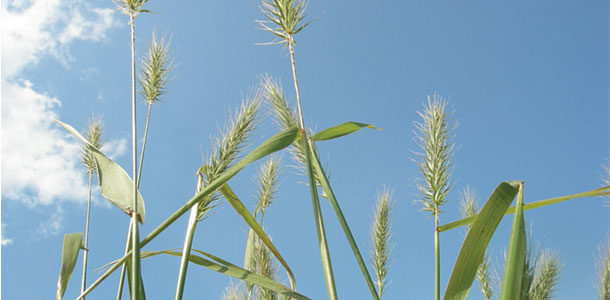Federal policies regarding invasive species, conservation plantings and cost-share farm programs have generated strong enthusiasm in converting old pastures and hay ground into rotational grazing systems comprised of native grasses.
These systems, typically planned to promote year-round grazing, are designed with cool-season and warm-season components (i.e., combinations of annual and perennial grasses along with legumes).
When considering native grasses for these systems, there are relatively few cool-season species commercially available for use and even fewer with improved agronomic traits.
For areas in the South, native warm-season grasses are a great addition to any rotational grazing system due to their drought tolerance, fairly high nutritional quality and ability to provide excellent cover and foraging habitat for a suite of ground-nesting birds and small mammals.
These native warm-season grasses can be rotationally grazed from April (depending on location) through July if managed properly.
Cool-season species that can fill the fall, winter and early spring forage gap are needed to allow these native warm-season grasses paddocks adequate rest and to meet nutritional requirements of grazing livestock during this time period.
Species that typically fill this gap are tall fescue, orchardgrass (more northern latitudes), annual ryegrass and small grains (oats, barley and rye).
However, for those interested in implementing a completely native system, very few species are available and even fewer have been evaluated as a forage or improved to enhance forage characteristics.
Southeastern wildrye
Southeastern wildrye has been identified as one of the potential native cool-season grasses that could fill the forage gap in the completely native system.
Originally, this species was described as a variety of Canada wild rye, and at times has been mistaken for Virginia wildrye, but has recently been recognized as a distinct species (2007).
This grass is a tall (4 foot), erect, bunch-type perennial grass related to domesticated wheat and rye.
Southeastern wildrye is particularly sun-tolerant and quite prolific in field borders and abandoned fields throughout the Southeast. It has an upright, robust stature that tolerates a wide variety of soil conditions: from moist to dry soil, full sun to part shade, coarse to fine soil substrate and acid to neutral soil pH.
One characteristic that sets this species apart, however, is its high innate germination percentage. Typically, native species have high levels of dormancy that require pre-chilling or scarification (physically scarring the seed to promote germination) procedures to alleviate low percentages. Southeastern wildrye germination percentages, however, range from 40 to 70 percent with no genetic improvements on this trait.
Establishment
Successful establishment can be ensured through proper fertility management. Make sure moderate to high levels of potassium and phosphorous are present at the establishment site to promote root and crown development.
Nitrogen is not recommended during the establishment year, as this will encourage weed competition.
Nitrogen can be applied the following year, once plants have matured, and should be based on soil test recommendations and grazing management or haying management decisions. Refer to soil test recommendations prior to planting to address any other deficiencies or required amendments.
Pre-plant burndown applications of glyphosate are recommended to limit weed pressure prior to sowing. This procedure may require multiple applications (up to a year in advance) in order to effectively remove all undesirable vegetation and to control emerging seed present in the weed seed bank.
Other herbicides may be needed where invasive species or sod-type forage grasses are present (i.e., bahiagrass, bermudagrass, tall fescue, etc.).
Prepare a clean, firm seedbed by disking, harrowing and firming with a cultipacker or roller prior to establishment. If a no-till planter is available, tillage may not be necessary.
Southeastern wildrye can be sown at any time of the year; however, optimum germination and seedling development will only occur during cool, moist weather. When establishing a species mix (for conservation purposes), Southeastern wildrye can be sown at the same time as native warm-season grasses, forbs and legumes.
For monocultures of Southeastern wildrye, fall establishment is recommended to allow for root development prior to winter and vernalization (period of cool, wet conditions to promote germination) of ungerminated seed.
Optimum soil temperatures for sowing should be between 60 and 68ºF. Southeastern wildrye should be planted at a rate of 20 pounds pure live seed per acre drilled. If broadcasting, seeding rate should be increased (30 pure live seed pounds per acre), and seed should be tamped with a cultipacker following sowing to ensure good seed-to-soil contact.
If drilled, seed should be planted at ¼-inch to ½-inch deep. With proper weed control and optimum germination conditions, seedlings can reach 5 inches tall within 30 days of germination and can reach full height and reproductive maturity in their first year.
Management
Southeastern wildrye can withstand light grazing. Rotational grazing is recommended for stand preservation. Like other native grasses, it does not respond well to frequent defoliation and thus requires substantial rest between rotations or hayings. Plants should not be grazed or cut lower than 5 to 6 inches.
This will ensure stand longevity by allowing plants to store and conserve carbohydrate reserves in the crown of the plant and also maintain a vegetative state that promotes tillering.
Defoliation should occur every 20 to 30 days to maintain high forage quality. If haying, harvests should be conducted like other perennial forage grasses where cutting takes place prior to jointing (seed-head development) to capture the highest forage quality and quantity.
One harvest can be expected (4 to 5 tons per acre), as summer heat forces the plants into dormancy. As with other forages, Southeastern wildrye is nitrogen responsive; therefore, traditional approaches for hay and grazing management can be taken regarding nutrient removal.
In terms of forage quality, Southeastern wildrye is comparative to non-native perennials such as tall fescue and orchardgrass (Table 1).
Analysis of crude protein (CP), neutral-detergent fiber (NDF) and acid-detergent fiber (ADF) indicate relatively high innate nutritional values that can meet dietary requirements for livestock.
Research conducted at Mississippi State University showed that CP levels for Southeastern wildrye ranged from 11.1 to 18.0 percent for seven different harvests (with no nitrogen applications).
For the same harvests, NDF ranged from 47.3 to 59.1 percent, and ADF was 24.7 to 35.7 percent. When compared to other perennial cool-season forages, Southeastern wildrye tended to mature later in the spring, thus remaining vegetative longer into the summer months.
This delayed maturity can be beneficial in rotationally grazed systems which will allow warm-season species ample time to produce enough above-ground biomass for grazing.
In summary, Southeastern wildrye can be a native, cool-season option for those interested in implementing a completely native grazing or haying system. Seed sources, however, are extremely limited. FG
References omitted due to space but are available upon request. Click here to email an editor.
PHOTO
Photo courtesy of Brett Rushing.

Brett Rushing
Research Associate III
Department of Plant and Soil Sciences
Mississippi State University









